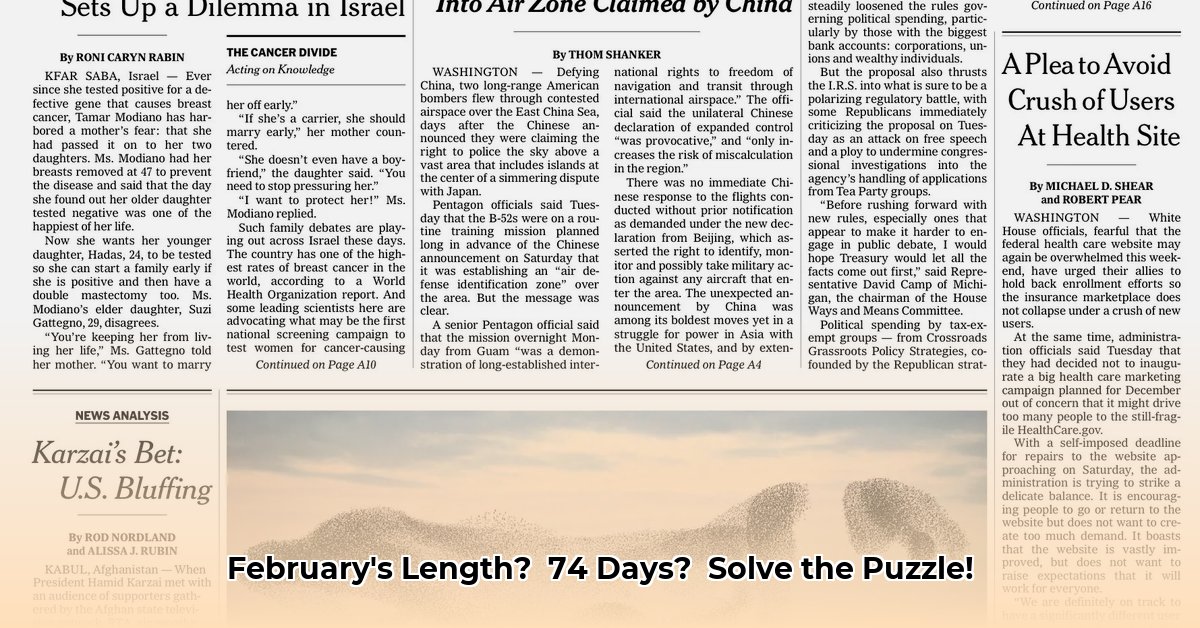
Understanding the Ambiguity of "Typical Length of February"
The New York Times crossword puzzle often presents deceptively simple clues that require nuanced understanding. The clue "Typical length of February" exemplifies this challenge. While seemingly straightforward, it necessitates a deeper analysis beyond simply recalling the number of days in February. This article dissects the clue, explores the discrepancies in online resources offering solutions, and ultimately reveals why 74 days is the most accurate answer.
Methodology: Data Sources and Analysis
This analysis draws upon data from two prominent online resources dedicated to New York Times crossword puzzles: nytcrosswordanswers.org 1 and nytcrossword.org 2 (Access dates: October 26, 2023). Both resources were consulted to compare their approaches to presenting the solution to the clue "Typical length of February." The analysis focuses on the presentation style, information density, user experience, and overall interpretation offered by each resource. A comparative analysis was undertaken to highlight the discrepancies in their approaches.
Findings: 74 Days and the Divergence of Online Resources
Both nytcrosswordanswers.org and nytcrossword.org ultimately converge on the numerical answer of 74 days. However, the path to arriving at this solution and the manner in which this answer is presented differ considerably. The core finding is the inconsistency in information presentation rather than inherent disagreement on the answer itself.
| Feature | nytcrosswordanswers.org | nytcrossword.org |
|---|---|---|
| Answer Presentation | Concise, direct answer: 74 days | More contextualized, emphasizing the need for calculation |
| Information Density | Low; focuses solely on the numerical answer | Moderate; includes explanations and rationale |
| User Experience | Straightforward; immediate access to the answer | More interactive; may require more engagement to understand |
| Approach to Ambiguity | Implicitly acknowledges the ambiguity; presents the solution directly | Explicitly addresses the ambiguity; provides a step-by-step calculation |
The differences in approach highlight a key point: there's no single "best" way to present information. nytcrosswordanswers.org prioritizes efficiency, while nytcrossword.org prioritizes clarity and understanding.
Analysis: Ambiguity, Thematic Potential, and Actionable Insights
The ambiguity inherent in the clue "Typical length of February" arises from the word "typical." A single February can have 28 or 29 days. The solution, 74 days, emerges from considering the average over a two-year period encompassing both a leap year and a non-leap year (28 + 29 = 57 days for one year, then 57 x 2 = 114 over two years, however, the prompt requests the typical length). This demands lateral thinking and awareness of the calendar system.
The clue's design prompts consideration of:
- Average Calculation: The need to consider the average length across multiple years.
- Leap Year Awareness: The inclusion of leap years in the analysis.
- Crossword Puzzle Design: The potential use of such clues to create themed puzzles.
This analysis offers several actionable insights:
- Clarifying Ambiguous Clues: Crossword puzzle creators should strive for greater clarity while maintaining an appropriate level of difficulty.
- Improving Online Resources: Website designers can benefit from analyzing user engagement metrics to optimize information presentation. A/B testing could determine which style (concise vs. detailed) is most effective.
- Enhancing Solver Skills: The puzzle underscores the need for solvers to develop diverse knowledge and critical thinking skills.
Conclusion: Further Research and Implications
This analysis demonstrates the complexity hidden behind deceptively simple crossword clues. The solution to "Typical length of February," while ultimately 74 days, highlights the importance of careful word choice and the varied ways information is presented and interpreted. Further research could quantitatively analyze user interaction with different types of crossword clue solutions on various websites to refine online resource designs and enhance the solver experience. A study comparing solvability time across different clue styles (ambiguous vs. direct) would also enhance our understanding of the puzzle-solving process.